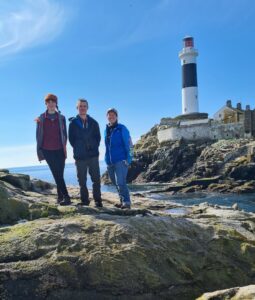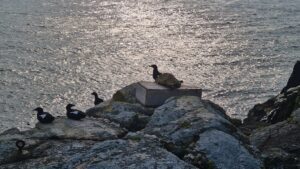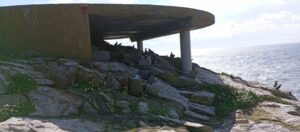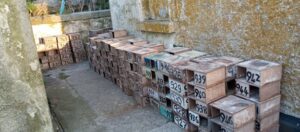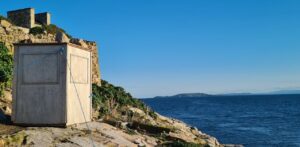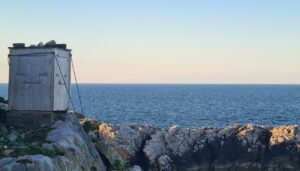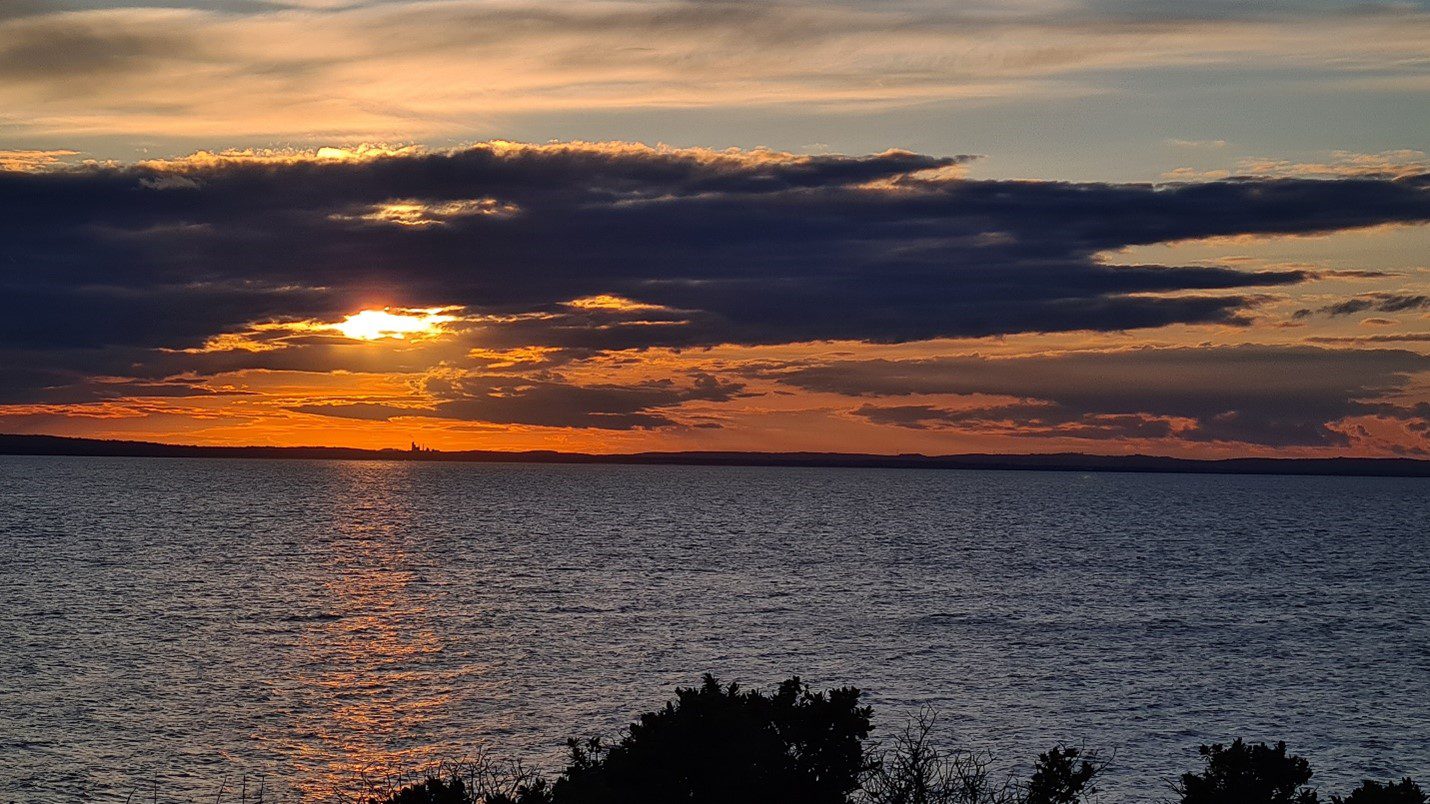
Led by Project Manager Dr. Stephen Newton, the three Rockabill wardens have eagerly begun our NPWS-funded work on Rockabill and are very excited for what the season will bring. We have already been here for two weeks, and what a fortnight it has been!
In just 14 days, Rockabill has transformed into a hub of seabird activity. The island has gotten progressively noisier, resonating with the calls of black Guillemots and Kittiwakes, and now, of Common Terns, Arctic Terns, and Roseate Terns. Our days have been filled to the brim with preparations, ensuring that the island is primed and ready to accommodate the nesting needs of these birds.
Meet the Rockabill Wardens
Rockabill’s 2024 resident tern wardens- Emma (left), Kyle (middle), and Rochelle (right).
Rochelle Streker
This is Rochelle’s first season as a warden on Rockabill, having moved to Ireland from the United States last year. Rochelle has lots of seabird and conservation experience all across America, including working with and surveying Black Skimmers, Wilson’s Plovers, Red Knots, Newell’s Shearwaters, American Oystercatchers, Marbled Murrelets, Bald Eagles, and many different species of terns. She has also completed a master’s in wildlife biology from Clemson University on the reproductive ecology of Brown Pelicans in the northern Gulf of Mexico. As she settles into her new Irish life in Dublin, she is looking forward to learning more about Irish conservation and having a great season out on Rockabill!
Emma Roberts
Emma, a newcomer to the Rockabill warden team, holds a zoology degree from the University of Galway and is nearing completion of her PhD focused on urban red squirrel ecology. During her time in Galway, Emma volunteered with the Galway and Claddagh Swan Rescue and devoted her time to rescuing and rehabilitating, injured birds, including feral pigeons, Woodpigeons, Mute Swans, Herring Gulls, Black-headed Gulls, Mallards, Grey Herons, and the occasional Guillemot! Emma, an enthusiastic bird watcher with a particular affinity for seabirds, is very excited to learn more about seabird conservation and kickstart her career with a season on Rockabill.
Kyle Coughlan
Kyle is a Dublin native and studied for his B.Sc. in Zoology and M.Sc. in Evolutionary Biology at UCD and returned to Ireland in April after nearly seven years abroad. Following university studies, he spent a year working with in the south of France with a group focused on the conservation of the European Roller. Then he worked towards at Ph.D. at the Jagiellonian University in Krakow where he studied Great Tits and Blue Tits in the forests of northern Poland. Having recently submitted his thesis he is very much looking forward to spending his first summer on Rockabill with the terns.
Preparing the Island
After arriving at Rockabill on the 24th of April, the three of us and Steve quickly began preparing the island for the arrival of the Common, Roseate, and Arctic terns. Additionally, we’ve been observing the activity of the Black Guillemots and Kittiwakes that have already arrived on Rockabill and have begun searching for nesting sites.
As the black guillemots are already on the island, we quickly began setting up nest boxes for them. These birds favour nesting in secluded, dark crevices within rocky formations. So far, we have set up black guillemot nest boxes beneath the Helipad, a preferred nesting spot for these birds, and on the rocks to the north of the island where we’ve observed pairs congregating.
Black Guillemot pairs checking out the nest boxes on the rocks to the north of the island (top) and under the helipad (bottom).
The main island is called the “Rock” and the smaller rocky island is called the “Bill”. While the Bill has very little vegetation, the Rock is covered in a densely growing plant called tree mallow. It takes up so much of the ground area on the island that there is no room for common, arctic, and roseate tern nests. Its swift removal was our next port of call. First, we removed the tree mallow from our study sites and then went about removing it from the remainder of the main island.
We also had to organise our nest boxes for the Roseate Terns. The nest boxes were taken out of storage and organised by number from 00 to 948! Some of the boxes were broken or damaged during the last breeding season, so these boxes were repaired if feasible. Additionally, new boxes were constructed and labelled with ID numbers to fill any gaps. With a considerable number of nest boxes on hand, our aim is to maximize nesting opportunities for the roseate terns by deploying as many boxes as we can.
Roseate Tern nest boxes.
Next came the 5 hides, which are required to monitor the nesting terns without disturbing them. We assembled the hides at vantage points across the island. They were then weighed down with heavy rocks and tied down with rope in order to prevent them from being blown away in any storms. Luckily, we got the hides set up and secured in time for our first stormy day!
2 of the 5 hides set up around the main island.
On Saturday the 27th of April, we were visited by the Geological Society of Ireland, who spent a few hours on the island looking at Rockabill Granite. The members of the GSI were kind enough to help us remove tree mallow from various study sites. We really appreciated having more hands to help us with the removal! When the GSI left that evening, Steve joined them and headed back to the mainland.
With Steve’s departure us wardens got busy setting up all of the Roseate Tern nest boxes around the island. First, we set up boxes around each of the assigned study sites, which can be monitored from the hides. Next, we started setting up the remainder of the nest boxes around the island. Aside from two stormy days with strong winds, rain, and high waves, we have been very lucky with the weather. A succession of clear days allowed us to finish setting up all of the nest boxes. Just in the nick of time too because this week- the terns arrived!
First, the terns started circling the lighthouse in the AM. Every day they began flying lower and lower to the ground. Now, plenty of them have started landing on the island and looking for places to nest. We have spotted all 3 species of tern so far; Common Terns, Roseate Terns, and Arctic Terns. With their arrival, the island has gotten progressively noisier. We are very excited for them to start nesting so that we can continue to monitor them and start ring reading.
And there you have it! Stay tuned for more updates as we navigate through the season’s tern of events.
– Emma, Rochelle, and Kyle
This year’s work to protect and monitor the terns and other breeding seabirds on Rockabill would not be possible without the support from the National Parks and Wildlife Service and the cooperation of the Commissioners of Irish Lights.

